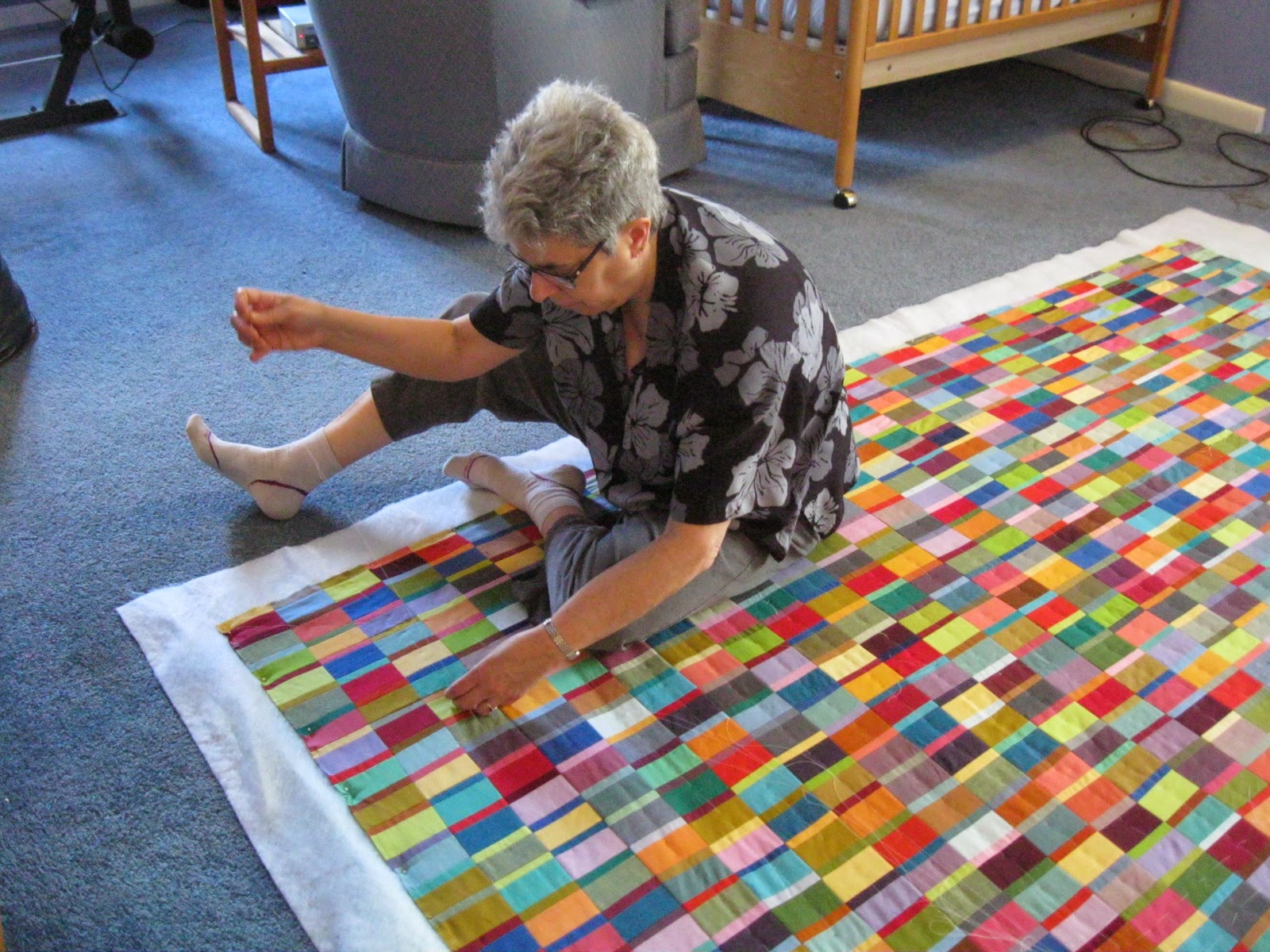I recently finished piecing the shot cotton "Plain Spoken" quilt. The next step was to figure out what I wanted to do for the quilting. On an earlier shot cotton quilt, made from just the larger-size rectangles, I machine quilted a grid, and then added hand-quilting with embroidery thread, a simple line inside each rectangle. I thought of doing similar hand-work on this quilt, so I tried it out on the sample above, right column. Too boring, and the narrower rectangles needed a different treatment. I've been wanting to expand my embroidery repertoire, so I decided to play with some embroidery stitching instead (working it through the three layers of top, batting, and backing, so that it serves as quilting as well)--done in the middle and left columns above. I love how this looks! So, my plan is to do vertical stitch-in-the-ditch in the seams between each column to secure everything, and then to do embroidery in the narrow rectangles (0.5 x 3"). I won't do any stitching at all in the larger rectangles (1.5 x 3"). It will take me a year or two to complete, but it will be a pleasure to do. There are 1,440 narrow rectangles in this quilt, and I'm thinking I'll try to do something different in each one. I've been going through embroidery books, picking out stitches that will be usable for this project, and so far have about 150 different stitches (e.g., back stitch, lazy daisy, French knot, etc.). Since many of these stitches can be used in multiple ways, I think it's possible to come up with 1,440 variations, especially since the straight stitch (example in lower left corner above) is basically a short drawn line, so there are as many variations as one could make with a drawn line. . .
With a quilting plan in place, the next step was to baste together the three layers of the quilt. I usually secure the layers by spray-basting, with the layers pinned to a vertical design wall--a method I learned from a Patsy Thompson video. But this quilt is 90 x 112 (for a queen-size bed), and the spray-basting works best for something smaller, and for something done by machine rather than hand-quilting. I decided to baste this on a low-nap carpet, a method described by Suzanne Marshall in her book Take-Away Appliqué, pp. 78-79. I have a large carpeted area in the finished attic of my house that I could use. First, the back gets pinned to the carpet, all around the edges:

Then the batting is smoothed out onto the backing. (For hand-quilting, I use Hobbs Poly-Down.) Then the top is smoothed out over the batting and secured with pins around all the edges.

Then, you sit on the quilt and baste it! I've never tried this before, as I couldn't believe the quilt wouldn't shift from my moving around on it, and I also thought it would be a strain on my back.
But it has been working well. I do only a half-hour at a time, twice a day. After a week, I'm about half-way through. I'll have to up the number of stints to three times a day, as I've got a guest coming into the guest room on Friday!
I'm stitching in the middle of every column, and in the middle of each row of larger rectangles. It's a pleasure to be looking at all the color combinations close up.





What a wonderful quilt. It is so lively and bright. I give you a lot of credit for basting the quilt while sitting on it!! I think you said this one was for you - GOOD! That is a lot of work. Keep posting your progress
ReplyDeleteI love the colors and I know exactly what you mean about enjoying the color combinations up close. Sometimes when I'm quilting my hand-dyed fabrics, I get mesmerized by the colors as they go past. Leads to wonky quilting!
ReplyDeleteThis is going to be fantastic! You will certainly get your fill of embroidery over whatever time it takes. I especially like the flowers on the small teal-colored rectangle.
ReplyDeleteCookie
Penny, Your quilt is beautiful! Whatever you do to quilt/ embroider will add that special touch...may be awhile for the end product. I'm glad you're a patient and disciplined artist!
ReplyDelete